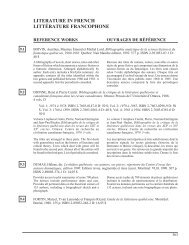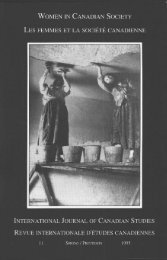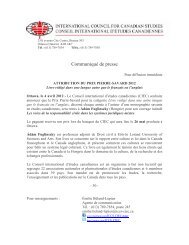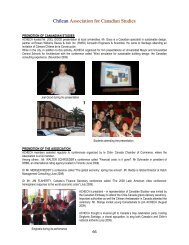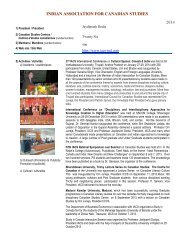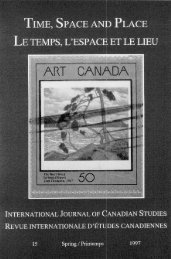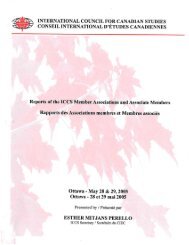Arts and Literature in Canada:Views from Abroad, Les arts et la ...
Arts and Literature in Canada:Views from Abroad, Les arts et la ...
Arts and Literature in Canada:Views from Abroad, Les arts et la ...
- No tags were found...
Create successful ePaper yourself
Turn your PDF publications into a flip-book with our unique Google optimized e-Paper software.
Refigur<strong>in</strong>g the Mother: Quebec Women Writers <strong>in</strong> the 80sNotes1. An earlier version of this essay was presented at the Association of Canadian Studies <strong>in</strong> theUnited States Biennial Conference <strong>in</strong> Boston, November 1991.2. See Jean Le Moyne, “La femme dans <strong>la</strong> civilisation canadienne-française,” Convergences(Montreal: HMH, 1969), p. 79.3. See the excellent study by Jan<strong>in</strong>e Boynard-Frot, Un matriarcat en procès: analysesystématique de romans canadiens-francais, 1860-1960, which considers the impact onfemale characters of the ideology <strong>and</strong> conventions of this sub-genre.4. The significance of this early text for the subject of this essay was first brought to myattention by Lori Sa<strong>in</strong>t-Mart<strong>in</strong> <strong>in</strong> her essay, “Writ<strong>in</strong>g (Jump<strong>in</strong>g) Off the Edge of the World:M<strong>et</strong>afem<strong>in</strong>ism <strong>and</strong> New Women Writers of Quebec,” to be published <strong>in</strong> Beyond theHexagon: Women Writ<strong>in</strong>g <strong>in</strong> French, eds. Karen Gould, Mary Jean Green, Michel<strong>in</strong>e Rice-Maxim<strong>in</strong>, Keith Walker, Jack Yeager.5. See Patricia Smart’s <strong>in</strong>-depth fem<strong>in</strong>ist look at the roman du terroir (Jean Rivard, MariaChapde<strong>la</strong><strong>in</strong>e, Menaud maître-draveur, Trente arpents) <strong>in</strong> her engag<strong>in</strong>g study of the Quebecnovel, Écrire dans <strong>la</strong> maison du père: L’émergence du fém<strong>in</strong><strong>in</strong> dans <strong>la</strong> tradition littéraire duQuébec (Montréal: Québec/Amérique, 1988).6. Mary Jean Green offers an additional historical context for underst<strong>and</strong><strong>in</strong>g the daughter’shostility toward the mother <strong>in</strong> B<strong>la</strong>is’s early novels <strong>and</strong> particu<strong>la</strong>rly <strong>in</strong> Une saison dans <strong>la</strong> vied’Emmanuel <strong>in</strong> which, Green argues, “B<strong>la</strong>is specifically attacked the repressiveness of amother-daughter re<strong>la</strong>tionship based on identity <strong>and</strong> rep<strong>et</strong>ition—a re<strong>la</strong>tionship much like theone shown <strong>in</strong> Maria Chapde<strong>la</strong><strong>in</strong>e. In B<strong>la</strong>is’s vision, the role assigned to women bytraditional Quebec soci<strong>et</strong>y reduces her to the status of a nameless, faceless animal, whoseonly function is to bear, feed, <strong>and</strong> often bury an unend<strong>in</strong>g series of babies.” See Green’sessay, “Redef<strong>in</strong><strong>in</strong>g the Maternal: Women’s Re<strong>la</strong>tionships <strong>in</strong> the Fiction of Marie-C<strong>la</strong>ireB<strong>la</strong>is,” <strong>in</strong> Traditionalism, Nationalism, <strong>and</strong> Fem<strong>in</strong>ism: Women Writers of Quebec, ed. Pau<strong>la</strong>Gilbert Lewis (Westport, Connecticut: Greenwood Press, 1985), p. 128.7. Barbara Godard offers an <strong>in</strong>terest<strong>in</strong>g read<strong>in</strong>g of Élisab<strong>et</strong>h’s condition of outsider, argu<strong>in</strong>gthat despite the hero<strong>in</strong>e’s rebellious acts <strong>and</strong> positive steps toward self-awareness, sherema<strong>in</strong>s repressed by soci<strong>et</strong>y as evidenced <strong>in</strong> her f<strong>in</strong>al “refuge <strong>in</strong> Jérome [the patriarch] <strong>and</strong>his fictional vision of her” (Godard, p. 28). See Barbara Godard, “My (m)Other, My Self:Strategies for Subversion <strong>in</strong> Atwood <strong>and</strong> Hébert,” Essays <strong>in</strong> Canadian Writ<strong>in</strong>g 26 (Summer1983): 13-44.8. See Mary Jean Green, Pau<strong>la</strong> Gilbert Lewis <strong>and</strong> Karen Gould, “Inscriptions of the Fem<strong>in</strong><strong>in</strong>e:A Century of Women Writ<strong>in</strong>g <strong>in</strong> Quebec,” The American Review of Canadian Studies Vol.15, No. 4 (W<strong>in</strong>ter 1985), p. 373.9. See my discussion of motherhood <strong>and</strong> writ<strong>in</strong>g <strong>in</strong> the works of Gagnon <strong>and</strong> Bersianik <strong>in</strong>Writ<strong>in</strong>g <strong>in</strong> the Fem<strong>in</strong><strong>in</strong>e: Fem<strong>in</strong>ism <strong>and</strong> Experimental Writ<strong>in</strong>g <strong>in</strong> Quebec (Carbondale <strong>and</strong>Edwardsville: Southern Ill<strong>in</strong>ois University Press, 1990).10. France Théor<strong>et</strong>, “La mère, peut-elle être moderne?,” La Nouvelle Barre du jour 116 (1982):47-50.11. See my discussion of the mean<strong>in</strong>g of the phrase for Nicole Brossard <strong>and</strong> others formed at theLa Barre du jour <strong>in</strong> Writ<strong>in</strong>g <strong>in</strong> the Fem<strong>in</strong><strong>in</strong>e, pp. 52-53.12. Nicole Brossard, L’Amèr ou le chapitre effrité (Montreal: <strong>Les</strong> Qu<strong>in</strong>ze, 1977), p. 12.13. Patricia Smart is doubtless correct to <strong>in</strong>sist upon the centrality of the mother figure <strong>in</strong>Gabrielle Roy’s Bonheur d’occasion <strong>and</strong> the importance of the mother/daughter dialogue aswell. See Chapter 5 of Smart’s Écrire dans <strong>la</strong> maison du père.14. Karen Gould, “Vers une maternité qui se crée: l’oeuvre de Louky Bersianik,” Voix <strong>et</strong> images49, Vol. 17, N o 1 (automne 1991): 35-47.15. Adrienne Rich, Of Woman Born: Motherhood as Experience <strong>and</strong> Institution (New York:Bantam, 1976).16. Madele<strong>in</strong>e Gagnon, Antre (Montreal: <strong>Les</strong> herbes rouges, 1978), p. 40.17. Marianne Hirsch, The Mother/Daughter Plot: Narrative, Psychoanalysis, Fem<strong>in</strong>ism(Bloom<strong>in</strong>gton: Indiana University Press, 1989), p. 167.123



